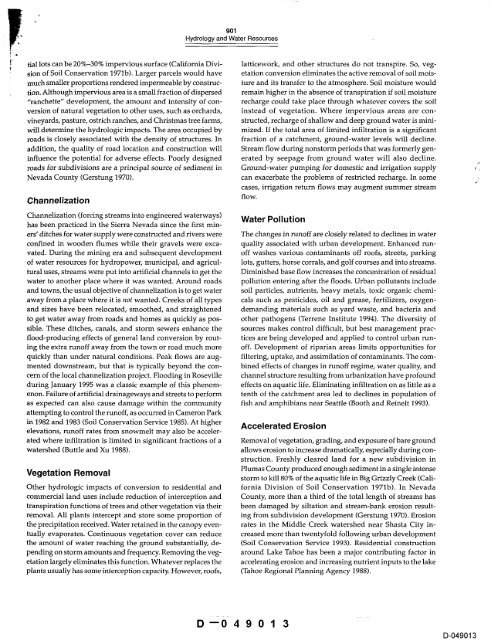D--048966 - CALFED Bay-Delta Program - State of California
D--048966 - CALFED Bay-Delta Program - State of California
D--048966 - CALFED Bay-Delta Program - State of California
You also want an ePaper? Increase the reach of your titles
YUMPU automatically turns print PDFs into web optimized ePapers that Google loves.
901<br />
Hydrology and Water Resources<br />
tial lots can be 20%-30% impervioussurface (<strong>California</strong> Divi- latticework, and other structures do nottranspire. So, vegsion<br />
<strong>of</strong> Soil Conservation 1971b). Larger parcels would have etation conversion eliminates the active removal <strong>of</strong> soil toolsmuch<br />
smaller proportions rendered impermeable by construc- ture and its transfer to the atmosphere. Soil moisture would<br />
tion. Although impervious area is a small fraction <strong>of</strong> dispersed remain higher in the absence <strong>of</strong> transpiration if soil moisture<br />
"ranchette" development, the amount and intensity <strong>of</strong> con- recharge could take place through whatever covers the soil<br />
version <strong>of</strong> natural vegetation to other uses, such as orchards, instead <strong>of</strong> vegetation. Where impervious areas are convineyards,<br />
pasture, ostrich ranches, and Christmas tree farms, structed, recharge <strong>of</strong> shallow and deep ground water is miniwill<br />
determine the hydrologic impacts. The area occupied by mized. If the total area <strong>of</strong> limited infiltration is a significant<br />
roads is closely associated with the density <strong>of</strong> structures. In fraction <strong>of</strong> a catchment, ground-water levels will decline.<br />
addition, the quality <strong>of</strong> road location and construction will Stream flow during nonstorm periods that was formerly geninfluence<br />
the potential for adverse effects. Poorly designed erated by seepage from ground water will also decline.<br />
roads for subdivisions are a principal source <strong>of</strong> sediment in Ground-water pumping for domestic and irrigation supply<br />
Nevada County (Gerstung 1970). can exacerbate the problems <strong>of</strong> restricted recharge. In some<br />
cases, irrigation return flows may augment summer stream<br />
Channelization flow.<br />
Channelization (forcing streams into engineered waterways) Water Pollution<br />
has been practiced in the Sierra Nevada since the first miners’<br />
ditches for water supply were constructed and rivers were The changes in run<strong>of</strong>f are closely related to declines in water<br />
confined in wooden flumes while their gravels were exca- quality associated with urban development. Enhanced runvated.<br />
During the mining era and subsequent development <strong>of</strong>f washes various contaminants <strong>of</strong>f ro<strong>of</strong>s, streets, parking<br />
<strong>of</strong> water resources for hydropower, municipal, and agricul- lots, gutters, horse corrals, and golf courses and into streams.<br />
tural uses, streams were put into artificial channels to get the Diminished base flow increases the concentration <strong>of</strong> residual<br />
water to another place where it was wanted. Around roads pollution entering after the floods. Urban pollutants include<br />
and towns, the usual objective <strong>of</strong> channelization is to get water soil particles, nutrients, heavy metals, toxic organic chemiaway<br />
from a place where it is not wanted. Creeks <strong>of</strong> all types cals such as pesticides, oil and grease, fertilizers, oxygenand<br />
sizes have been relocated, smoothed, and straightened demanding materials such as yard waste, and bacteria and<br />
to get water away from roads and homes as quickly as pos- other pathogens (Terrene Institute 1994). The diversity <strong>of</strong><br />
sible. These ditches, canals, and storm sewers enhance the sources makes control difficult, but best management pracflood-producing<br />
effects <strong>of</strong> general land conversion by rout- tices are being developed and applied to control urban runing<br />
the extra run<strong>of</strong>f away from the town or road much more <strong>of</strong>f. Development <strong>of</strong> riparian areas limits opportunities for<br />
quickly than under natural conditions. Peak flows are aug- filtering, uptake, and assimilation <strong>of</strong> contaminants. The commented<br />
downstream, but that is typically beyond the con- bined effects <strong>of</strong> changes in run<strong>of</strong>f regime, water quality, and<br />
cern <strong>of</strong> the local channelization project. Flooding in Roseville channel structure resulting from urbanization have pr<strong>of</strong>ound<br />
during January 1995 was a classic example <strong>of</strong> this phenom- effects on aquatic life. Eliminating infiltration on as little as a<br />
enon. Failure <strong>of</strong> artificial drainageways and streets to perform tenth <strong>of</strong> the catchment area led to declines in population <strong>of</strong><br />
as expected can also cause damage within the community fish and amphibians near Seattle (Booth and Reinelt 1993).<br />
attempting to control the run<strong>of</strong>f, as occurred in Cameron Park<br />
in 1982 and 1983 (Soil Conservation Service 1985). At higher Accelerated Erosion<br />
elevations, run<strong>of</strong>f rates from snowmelt may also be accelerated<br />
where infiltration is limited in significant fractions <strong>of</strong> a Removal <strong>of</strong> vegetation, grading, and exposure <strong>of</strong> bare ground<br />
watershed (Buttle and Xu 1988). allows erosion to increase dramatically, especially during construction.<br />
Freshly cleared land for a new subdivision in<br />
Vegetation Removal Plumas County produced enough sediment in a single intense<br />
storm to kill 80% <strong>of</strong> the aquatic life in Big Grizzly Creek (Cali-<br />
Other hydrologic impacts <strong>of</strong> conversion to residential and fornia Division <strong>of</strong> Soil Conservation 1971b). In Nevada<br />
commercial land uses include reduction <strong>of</strong> interception and County, more than a third <strong>of</strong> the total length <strong>of</strong> streams has<br />
transpiration functions <strong>of</strong> trees and other vegetation via their been damaged by siltation and stream-bank erosion resultremoval.<br />
All plants intercept and store some proportion <strong>of</strong> ing from subdivision development (Gerstung 1970). Erosion<br />
the precipitation received. Water retained in the canopy even- rates in the Middle Creek watershed near Shasta City intually<br />
evaporates. Continuous vegetation cover can reduce creased more than twentyfold following urban development<br />
the amount <strong>of</strong> water reaching the ground substantially, de- (Soil Conservation Service 1993). Residential construction<br />
pending on storm amounts and frequency. Removing the veg- around Lake Tahoe has been a major contributing factor in<br />
etation largely eliminates this function. Whatever replaces the accelerating erosion and increasing nutrient inputs to the lake<br />
plants usually has some interception capacity. However, ro<strong>of</strong>s, (Tahoe Regional Planning Agency 1988).<br />
D--04901 3<br />
[9-049013

















